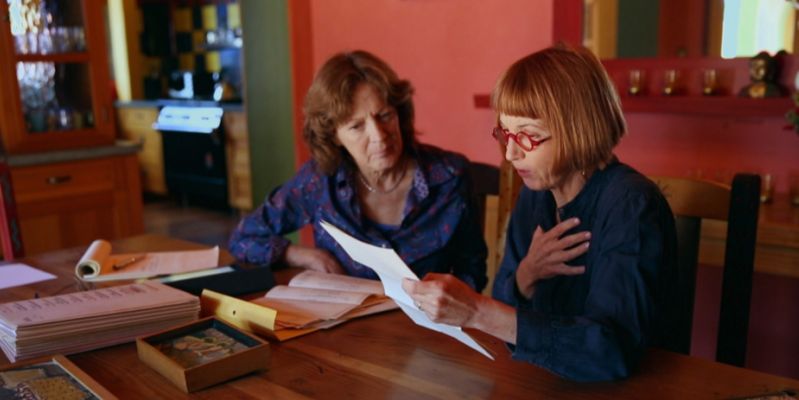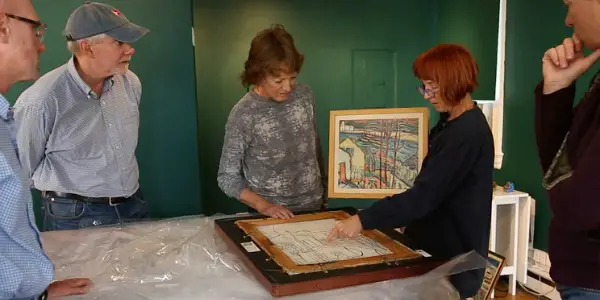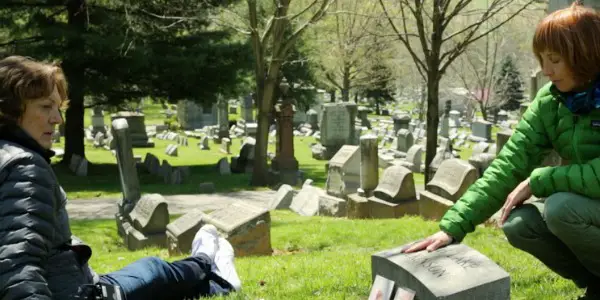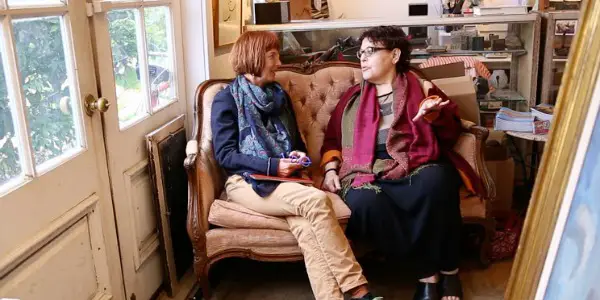PACKED IN A TRUNK: A Vibrant & Highly Enjoyable Documentary

I love film, more than people probably, and I will…
I love a good documentary, more than that I love a good mystery. While documentaries such as The Wolfpack have great stories, it’s the films that delve into the depths of the truth that really shine through for me. Finding Vivian Maier and Carol Morley’s Dreams Of A Life excel at this. Being about people who can no longer speak for themselves the filmmakers are compelled to try harder in their quest for the truth, or maybe without a person to guard the privacy of the story they feel they can ask more sensitive questions. Perhaps this is also the case in more contemporary subject matters, where filmmakers are distant from the object of their inquiry, such as those in the cases of Inside Job and Going Clear.
However, it is my belief that what separates an okay documentary from a truly great one is the passion of the filmmakers investigating the subject matter and the evidence they use to back up their line of inquiry. Case in point is the documentary Packed In A Truck: The Lost Art Of Edith Lake Wilkinson.
About the life of artist Edith Lake Wilkinson and told from the point of view of her great-niece, writer & producer Jane Anderson (known for her award winning work on Olive Kitteridge), it is an emotional, enthusiastic, and above all satisfying look at the life of Wilkinson and the legacy Anderson has grown in her wake.
Just Like Any Another Story?
It won’t have escaped the attention of many documentary lovers, or even ordinary film lovers, that recently there has been a great surgence in the popularity of the documentary. Most notably in the case of the mystery documentary. One that doesn’t simply document images or audio, but strives to uncover the mystery surrounding a person or place. It is essentially investigative journalism, and from cornerstones such as Searching For Sugar Man, the Serial podcast and the mini-series Making A Murderer a great new entertainment genre has found its feet.
With so many documentaries now appearing, and Netflix supporting so many new projects, it would be easy to lump Packed In A Trunk in with them. Another Finding Vivian Maier perhaps? But it’s so much more than that. Edith Lake Wilkinson was an artist, working in the 1920’s at what came to be a rather important artists colony; Provincetown on America’s Cape Cod. Halfway through what seems like a difficult but productive career Wilkinson was packed into a mental institution, then another, and there she remained until her death.

Surrounded by the paintings her mother rescued from a relative’s attic Anderson grew up around, and was heavily influenced by, Wilkinson’s work. At the age of 20 she moved to New York to pursue a career in art, and from there the parallels between her and Wilkinson come thick and fast. Not only do they paint similarly, but Wilkinson was also gay. Now approaching the age Wilkinson was when she was committed, Anderson is on a mission to uncover the mystery surrounding her great-aunt, and to restore a legacy she feels is missing.
The Enthusiastic Anderson
What makes Packed In A Trunk is Jane Anderson’s endearing enthusiasm for her great-aunt’s work. As the documentary follows her she tracks down the Provincetown buildings that appeared in Wilkinson’s work, she also imagines each new place as Wilkinson would have painted it. This makes the whole mystery so much more real, and the life of Wilkinson so much more immediate. Her great-niece’s exhilaration and energy in telling her story makes the whole film that much more exciting and enjoyable.

On this journey with Anderson is her wife Tess Ayers, who acts as a guiding force, but who also relishes the new information about Wilkinson. In Wilkinson and her partner Fanny’s relationship, Anderson and Ayers see their own reflected and their awareness of the freedom they enjoy as a gay couple in our contemporary society is not lost on them. Equally Anderson’s extended family revel in the story, generously adding to Wilkinson’s legacy.
What really made this film for me though is Anderson’s quest to have Wilkinson recognised. She goes from artist to artist, asking them to consider Wilkinson, asking for her to be given a place in the history they know. The positive outcomes, the justification of her admiration for her great-aunt, makes the point of the documentary that much more enjoyable. Because, as in the case of Finding Vivian Maier, this isn’t a simple case of a story. It’s about providing the foundations for a legacy, that Wilkinson and Anderson can now enjoy.
Finely Made
While Anderson and Ayers are the contemporary protagonists and in many ways the makers of Packed In A Trunk, it is the direction of Michelle Boyaner that really brings the whole thing home. The narrative of this documentary is quite brilliant. While it works chronologically, looking at Wilkinson’s and Anderson’s lives in tandem, it also circulates around Anderson’s planning of an exhibition of Wilkinson’s work (in Provincetown). So, while the film has order (which I love), it also has a core message. Whatever happened to Wilkinson, the important thing is that she is recognised now.
Boyaner builds on Anderson’s artistic eye and uses Wilkinson’s original artwork and elements of animation to bring life to the places the documentary visits. The musical accompaniment is lightly used and the filmmaking (i.e. the camera work and editing) is simple, yet effective, allowing the visual elements; Anderson’s red hair, the greyed wood of the houses, the flowers in the gardens, Wilkinson’s paintings, to shine through, giving the film its vibrancy.

Of course, every good narrative has to have an ending, and so keenly does Boyaner construct the narrative she pulls you to the edge of your seat. While the answers are not all there (how could they be? time being what it is), Boyaner’s encouragement of Anderson to consult a psychic medium happily fills in the blanks. Although I, and most likely you, don’t know what to make of such things, you have to hand it to Boyaner and the medium Lisa Williams. Even if this is all just based on educated judgements Williams does plug the gap in Wilkinson’s story. Even then, though, the fact that Anderson is as dubious as us makes the whole encounter lighter and less serious in tone. Categorising Williams’ version of events as a simple possibility, but intriguing nonetheless.
Conclusion
Packed In A Trunk could have been a very serious documentary about the history of homosexuality, the treatment of women, and mental illness, but it isn’t. Anderson doesn’t dwell too heavily on these things, even though they are considered, and this is probably for the best. There is not much Anderson can do to improve the former life of her great-aunt, but she can do something right now, to have her recognised. The personal nature of this film gives it great personality. It makes it about more than a person, it’s about the effection and admiration Anderson has for her great-aunt, more than that it’s about an artist wanting recognition for her peer.
Maybe it’s because I see so many aspects of my own life in this documentary, or maybe it is because it is so well-made, but I think perhaps it is the bold-faced enthusiasm and vibrancy of Packed In A Trunk that makes me like it so much. Documentaries tend to linger in the shadows, because drama sells, so to see one that is so excited and hopeful for its subject matter makes Packed In A Trunk a very lovely thing indeed.
Have you seen Packed In A Trunk? What did you think? Can you think of any other documentaries that have pursued forgotten artists?
Packed In A Trunk: The Lost Art Of Edith Lake Wilkinson was released on April 26th. It is available across all digital platforms including iTunes, Vimeo On Demand, and WolfeOnDemand.com. It is also available on DVD from Wolfe Video and some major retailers.
Does content like this matter to you?
Become a Member and support film journalism. Unlock access to all of Film Inquiry`s great articles. Join a community of like-minded readers who are passionate about cinema - get access to our private members Network, give back to independent filmmakers, and more.
I love film, more than people probably, and I will watch pretty much anything. Seriously, anything! I have a postgraduate education in film & have spent an exceptionally long time trying to get inside the film industry. I'm a big believer in treating every film the same, and bringing something new to the film theory table, giving reasons for every argument made. You'll find that I'm an empathetic and fun sort of reviewer, at least, I like to think so. If I'm not watching films I'm doing exceptionally nerdy stuff, like watching documentaries about the history of medicine and collecting photos of old post boxes.













